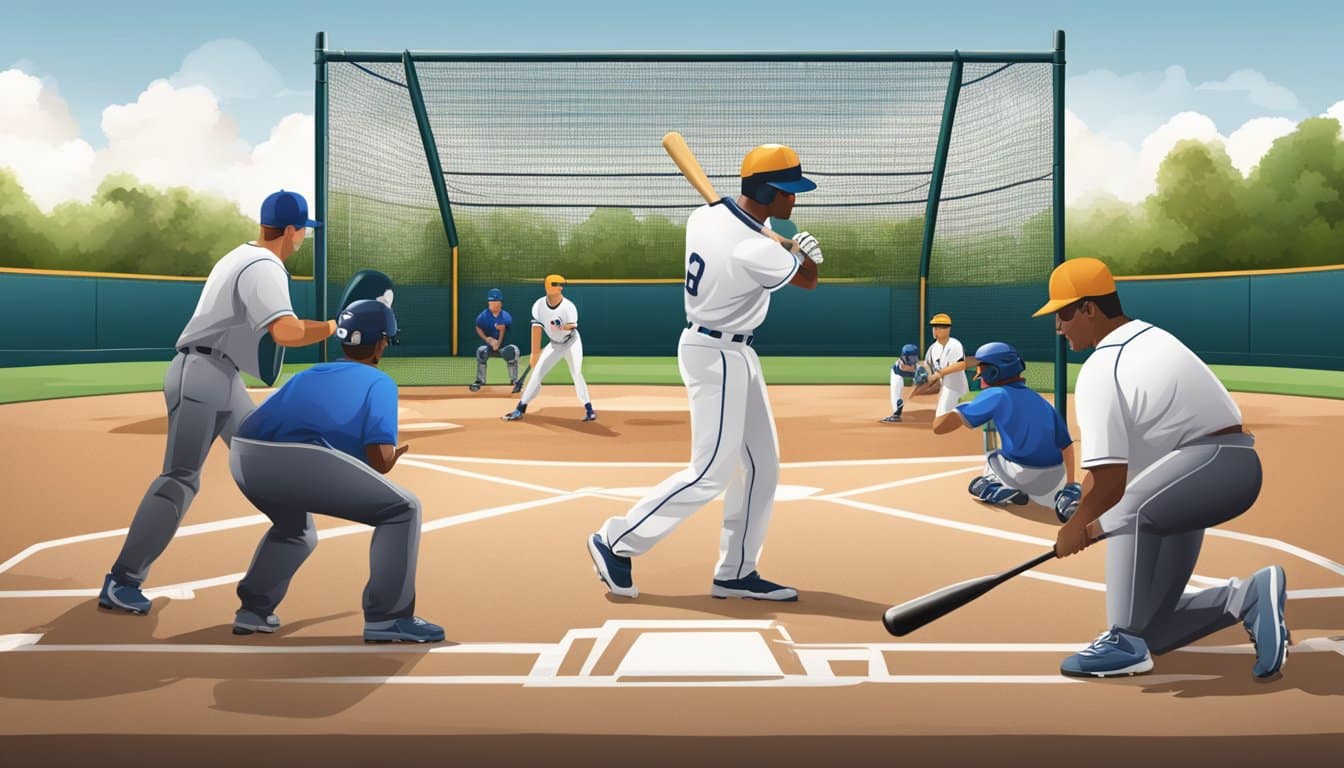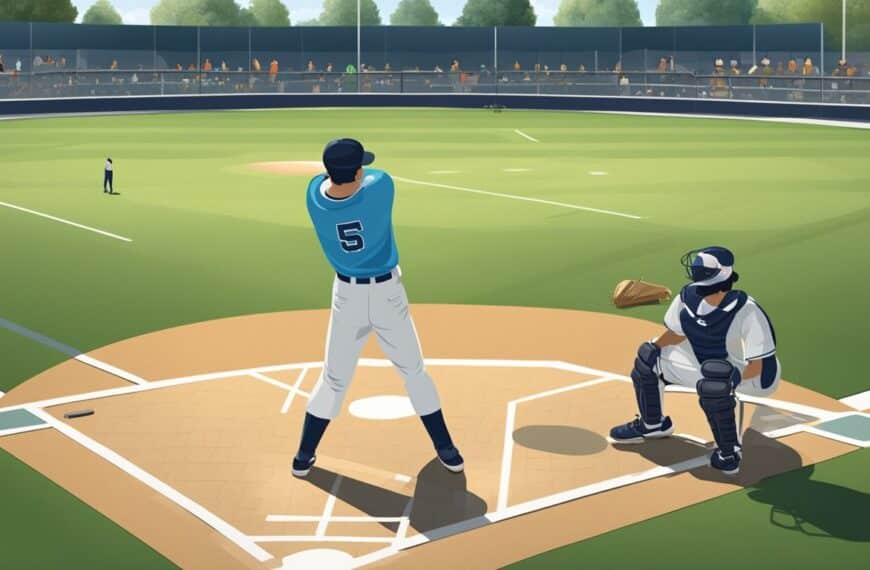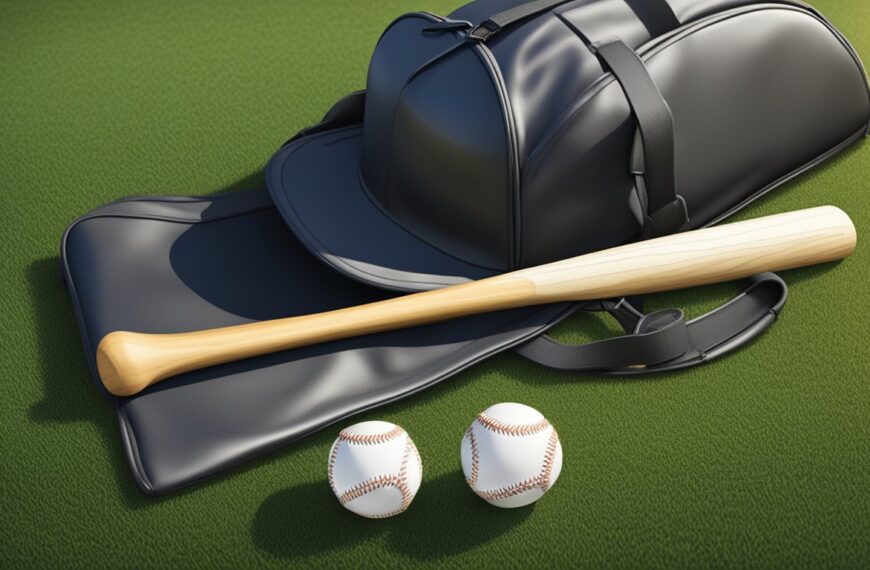Batting tees are an essential tool in baseball training, providing a stable hitting platform to develop a player’s swing mechanics. By using a tee, batters can refine their swings through repetition without the variables introduced by pitched balls. Incorporating batting tees into team training allows players to work on the precision of their hitting technique, focusing on the fundamental aspects of their swing, such as the stance, load, stride, and follow-through. This focused approach can lead to improved muscle memory and consistency at the plate.
For coaches and players, the versatility of batting tees extends beyond basic swing training. Advanced drills and techniques can be practiced, including inside and outside pitch hitting, as well as working on hitting balls at different vertical levels. Batting tees can be strategically used during practice to mimic game scenarios and fine-tune a hitter’s approach to various pitches. Additionally, integrating tee work into team training can aid in player development, helping batters understand the psychological aspects of hitting and how to maximize their practice time effectively.
Key Takeaways
- Batting tees aid in refining swing mechanics through focused practice.
- Tee workouts can incorporate advanced drills to simulate game situations.
- Effective use of batting tees contributes to both technical and psychological player development.
Basics of Batting Tees
https://www.youtube.com/watch?v=hXWwZkQ7rII&embed=true
Batting tees are fundamental to developing a baseball player’s swing mechanics and precision. They enable hitters to practice without the need for a pitcher, allowing for more repetitions and focus on form.
Choosing the Right Batting Tee
Selecting a quality batting tee is vital for effective training. A good batting tee should be durable, adjustable, and stable. Stability is key; it should not tip over easily during practice. Adjustability matters because it allows players to practice hitting pitches at various heights. Look for a tee with a wide height range to accommodate different players. A durable model withstands the rigors of regular practice and offers a long lifespan, providing value for the team’s investment.
Setting Up the Batting Tee
Proper setup of the batting tee is crucial for productive tee work. The tee should be positioned in direct alignment with home plate to replicate a realistic hitting experience. The height should be adjusted for the particular drill or player’s swing zone, ranging from low pitches to high strikes. Consistent placement ensures the development of a repeatable and powerful swing.
Tanner Tees: Types and Benefits
Tanner Tees offers several models, each with unique features suited to different training needs. The Tanner Tee features the patented FlexTop, a flexible rubber top that allows the bat to pass through the contact point with minimal resistance and feedback on the swing path. Tanner Heavy is a more robust version, designed with a heavyweight base to prevent tipping and enhance stability. Each Tanner Tee is built with quality materials, offering durability that withstands repeated use. They are a prime choice for athletes seeking to enhance their batting skills through focused tee work.
Developing Hitting Mechanics
https://www.youtube.com/watch?v=ka9XatIUA8U&embed=true
To harness the full potential of batting tees, coaches must prioritize the refinement of players’ hitting mechanics. This emphasis fosters consistency and power in hitting across various pitch locations.
Stance and Swing Mechanics
The foundation of effective hitting begins with a proper stance. Players should position their feet shoulder-width apart to ensure balance and stability. The knees should be slightly bent, and weight should be centered. Coaches can use tee drills to reinforce these fundamentals, watching for a fluid hip rotation and a level swing that utilizes the whole body. It is crucial to maintain a consistent swing plane with the barrel of the bat to drive the ball effectively.
Contact Points and Tee Placement
Understanding where to hit the ball in relation to the body is essential for effective contact. Coaches should use tee drills to instruct players on the various contact points:
- Inside pitches: Tee placed slightly behind the front foot
- Center pitches: Tee aligned with the player’s lead hip
- Outside pitches: Tee positioned opposite the back foot
Adjusting tee height and location helps batters learn to adapt their swing to strike the ball cleanly.
Drills for Enhancing Bat Path
To perfect the bat path, players can perform tee drills aimed at creating a short, direct route to the ball. The objective is to keep the barrel of the bat in the hitting zone as long as possible. Here are some specific drills:
- Vertical Bat Drill: Position the tee at varying heights to practice hitting low and high pitches.
- Walk-through Drill: Start with a back-step before swinging to enhance momentum and reinforce weight transfer.
- Soft Toss Variation: Interchange tee hitting with soft toss to transition from stationary to dynamic hitting scenarios.
These drills, when repeated, help in ingraining a consistent, powerful bat path.
Incorporating Tee Work into Practice
https://www.youtube.com/watch?v=ELo4zAOKTkg&embed=true
Batting tees are a valuable tool in baseball training, offering players a stable hitting platform to develop their swing. Tee work helps in refining batting technique, enhancing muscle memory, and reinforcing the mantra that practice makes perfect.
Solo Practice Routines
In solo practice, players should focus on repetitive swings to build muscle memory. A structured routine could begin with players hitting a set number of balls at various tee heights and angles to cover different pitch locations. For instance:
- Low Tee Drills: Set the tee at the lowest height for practicing hitting low pitches. Players should aim for 15-20 swings, focusing on driving through the ball.
- Middle Tee Drills: Adjust the tee to belt level. Players should take another 15-20 swings, this time concentrating on making direct contact with the center of the ball.
- High Tee Drills: Raise the tee to a high pitch level. Again, 15-20 swings should be performed, with the player working on hitting high pitches effectively.
Incorporating Inside, Middle, and Outside pitch locations at each height level can further diversify the training, ensuring comprehensive coverage of the strike zone.
Partner-Assisted Drills
Working with a partner can greatly enhance tee drills. Partners can provide immediate feedback on swing mechanics and help ensure the player maintains focus through the duration of the exercise. Partner-assisted drills include:
- Mirror Drills: The partner watches the player’s swing and provides real-time feedback on form and technique, emphasizing the maintenance of a balanced stance and proper follow-through.
- Soft Toss into the Tee: The partner soft tosses the ball into the tee just before the player swings. This drill improves timing and coordination as the player has to adjust to the ball placement by the partner.
Throughout these drills, the partner can also assist in adjusting the tee for different pitch locations, enabling the player to practice hitting in various strike zone areas without breaking rhythm.
Advanced Tee Drills and Techniques
https://www.youtube.com/watch?v=2TPPpeknChE&embed=true
Incorporating advanced tee drills into team training sharpens a player’s ability to anticipate and react to various pitch locations and types. It emphasizes the precision of a batter’s swing mechanics, bolstering their ability to direct the ball with intention.
Visualizing Pitch Locations
Players should practice visualizing an array of pitch locations by adjusting the tee height and position. For an inside pitch, the tee should be placed closer to the hitter’s body. Conversely, for an outside pitch, it’s set further away. This technique helps batters identify the optimal contact point for each pitch location.
Hitting to the Opposite Field
To encourage hitters to successfully hit to the opposite field, they must focus on the pitch’s timing and contact point. A drill involves setting up the tee on the outer half of the plate and instructing batters to wait slightly longer before initiating their swing. This allows the ball to travel deeper into the hitting zone, promoting an opposite field hit.
Adjusting for Pitch Types
Batters must adjust their stance and swing mechanics for different pitch types. The table below shows targeted adjustments for various pitches:
| Pitch Type | Tee Height | Swing Adjustment | Point of Contact |
|---|---|---|---|
| Fastball | Chest level | Quick hands, level swing | Out in front of the plate |
| Curveball | Thigh to knee | Stay back, uppercut swing | Closer to the body |
| Changeup | Waist level | Keep weight centered, delayed swing | Deeper in the hitting zone |
Through these drills, players enhance their adaptability, learning to tackle a diverse set of pitches and thereby increasing their chances of making solid contact during games.
Strategies for Player Development
https://www.youtube.com/watch?v=3m1qxXoPfUA&embed=true
Batting tees are foundational tools for honing a player’s hitting mechanics. They allow for repeatable practice and focused adjustments, setting the groundwork for later success against live pitching.
Youth Baseball and Softball Training
In youth baseball and softball, batting tees serve as one of the primary methods to teach proper swing technique. Coaches should:
- Emphasize bat path: Ensuring players understand how to create a level swing that matches the plane of the pitch.
- Focus on stance and posture: Encouraging a balanced, athletic stance and a consistent approach at the plate.
For successful tee work:
- Start with the tee at the player’s waist height and adjust for comfort and strike zone awareness.
- Incorporate various tee placements to simulate different pitch locations.
- Utilize drills that promote hand-eye coordination and strength, such as soft toss in conjunction with tee work.
Transitioning from Tee Work to Live Pitching
Moving from tee work to live pitching presents new challenges which require a thoughtful approach:
- Gradual increase in difficulty: Transitioning from a stationary ball to one thrown by a coach (coach pitch) and finally to live pitching.
- Pitch recognition and timing: Players should learn to recognize pitch types and locations, adjusting their swings accordingly.
Key strategies include:
- Introducing front toss: Where the coach pitches from a short distance to simulate the speed and angle of live pitching.
- Using pitching machines: To acclimate players to increased pitch speeds and maintain correct swinging mechanics.
Implementing these strategies helps players develop confidence and competence at the plate, essential for higher levels of play.
Maximizing Batting Practice
https://www.youtube.com/watch?v=vHZ4vUzDVJc&embed=true
To truly benefit from batting tees, teams must approach practice with precision and purpose. Every swing should contribute to the player’s growth, emphasizing continual analysis and tailored warm-ups.
Analyzing Swing and Adjusting the Tee
Player Development: Each hitter should begin with an evaluation of their swing mechanics. Coaches or players can use slow-motion video to identify areas of improvement, such as the swing path, stance, or point of contact.
Tee Adjustment: Based on the swing analysis, the tee should be adjusted to various heights and depths to challenge the player and address specific weaknesses.
| Tee Position | Focus |
|---|---|
| Lower Tee | Hitting low pitches |
| Middle Tee | Standard swing plane refinement |
| Higher Tee | High pitch engagement |
| Inside/Outside Tee | Work on inside/outside pitches |
Warm-Up Routines Before Games
Routine Structure: A structured warm-up routine is critical for preparing a hitter for the game. It should consist of:
- Dynamic stretches: to enhance flexibility and ensure muscle readiness.
- Light tee work: a series of gentle swings working on form, not power.
- Progressive hitting: starting with bunts and working up to full swings to incrementally engage muscles.
Focus on Game Situations: Hitters should simulate game scenarios by practicing hitting in various counts and imagined game situations, enhancing their focus and situational awareness.
Psychological Aspects of Hitting
https://www.youtube.com/watch?v=SjHCOWEphwg&embed=true
Mastering the psychological components of hitting can be as crucial as perfecting the physical techniques. A batter’s confidence and mental focus set the stage for a successful engagement at the plate.
Building Confidence at the Plate
Building confidence in a hitter is essential for peak performance. Batters with high confidence are more likely to face pitchers with a positive attitude and a belief in their ability to make contact. Coaches can foster this by incorporating batting tees in training to allow hitters to refine their swing mechanics in a low-pressure environment. A structured approach to repetitive practice on the tee can lead to:
- Improved consistency in swing, leading to better contact.
- A sense of achievement as they witness visible improvement.
Frequent successful contact during tee work enhances a hitter’s self-assurance, creating a positive feedback loop that carries over to live pitching scenarios.
The Importance of Focus and Visualization
Focus and visualization are powerful psychological tools a hitter can use to elevate their game. When a player stands at the plate, external distractions must fade away to maintain a deep focus on the incoming pitch. Batting tees provide a controlled setting for players to:
- Practice focusing on the point of contact without the unpredictability of a live pitch.
- Engage in visualization, imagining various pitch types and locations, and executing the swing accordingly.
By incorporating visualization techniques during tee drills, players can mentally rehearse their approach to different pitches, which helps in transferring these skills to actual game situations. The ability to visualize success at the plate can result in a more disciplined and prepared hitter.
Equipment and Maintenance
To optimize training, teams should invest in high-quality, durable equipment and commit to rigorous maintenance routines.
Selecting Quality Training Aids
When choosing batting tees, teams should prioritize quality and durability. A top-grade training aid is typically made of sturdy materials such as metal as opposed to plastic. Metal tees tend to endure repetitive use and adverse weather conditions. The base of the tee should be stable and possibly weighted to prevent tipping during practice. Moreover, an adjustable stem height is crucial to cater to various player sizes and swing types.
- Materials: Preferably metal or heavy-duty rubber.
- Base: Weighted for stability.
- Stem: Adjustable for player height and swing plane.
Maintenance and Care of Batting Tees
Regular maintenance ensures the longevity and effectiveness of batting tees. Teams should create a maintenance schedule to check the tightness of adjustable parts and the structural integrity of the equipment. Any signs of rust on metal parts can be addressed with rust-resistant spray. After practice, batting tees should be cleaned to remove dirt and stored in a dry place to prevent wear and tear.
- Routine Checks: Weekly inspection of adjustable parts and overall structure.
- Rust Prevention: Use of rust-resistant spray on metal parts.
- Storage: Clean and store in a dry area.
Frequently Asked Questions
Effective utilization of batting tees can significantly enhance players’ hitting skills. The following frequently asked questions address key aspects of integrating batting tees into team training.
How can batting tees be effectively used in youth baseball training?
Batting tees aid in youth baseball training by allowing players to focus on their swing mechanics without the variable of pitch timing. Coaches should emphasize a level swing path and proper stance while players repeatedly hit balls off the tee.
What are the best practices for setting up batting tees during team drills?
Coaches should position batting tees at various heights and locations in the strike zone to simulate different pitch types. This helps players learn to adjust their swing to various pitch locations. Ensuring that the tee is stable and at the correct height for the individual player is crucial.
In what ways can the use of batting tees be optimized for different skill levels?
For beginners, batting tees should be set at waist height to simplify the learning process. As skill level increases, coaches can introduce more complex drills, varying tee height and distance to challenge players and improve their adaptability to different pitches.
How can coaches incorporate batting tees into team training for advanced players, such as those at the MLB level?
At the MLB level, batting tees can be used for fine-tuning a player’s swing and focusing on specific areas of the strike zone. Coaches may use tee drills to address particular weaknesses or to prepare players for certain types of pitchers.
What drills can complement tee work in a team’s batting practice routine?
Incorporating soft toss drills, front toss, and live batting practice allows players to translate the mechanics focused on during tee work into more dynamic hitting situations. Integrating these drills helps reinforce the proper techniques developed from the tee.
How frequently should batting tees be used within a team’s overall training program?
Batting tees should be used regularly as part of a team’s training regimen. Frequency can vary, but consistent tee work, even as a brief component of each practice, ensures that players continually refine their hitting mechanics.










